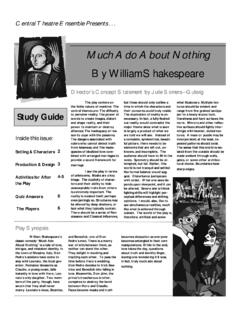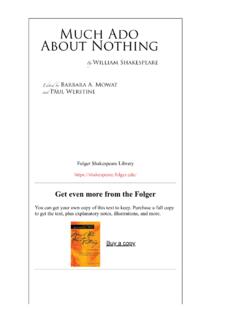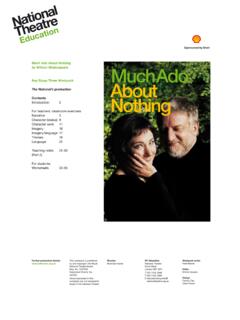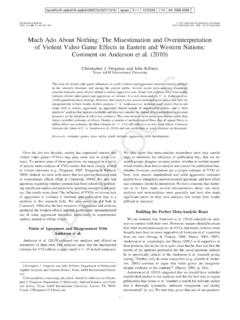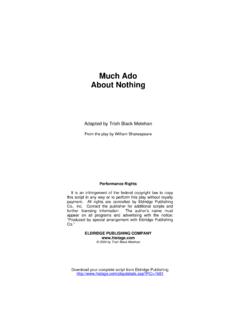Transcription of Much Ado About Nothing - MIT OpenCourseWare
1 Samantha Polak 11/17/03 Prof. Shankar Raman 21L009 much Ado About Nothing Kenneth Branagh s film version of William Shakespeare s much Ado About Nothing focuses on the relationship between Beatrice and Benedict and alters the play s depiction of several characters. The director s control over every aspect of the film allows him to show the audience his interpretation of the play very clearly. Branagh can shape the audience s opinion of each character by selecting lines that reveal specific traits of the speaker. The actor s presentation of those lines is equally important: a potentially serious line can be turned humorous with just a smile and a laugh, and serious scenes can be lightened as well if the order of the scenes is such that the serious scene follows a cheerful one.
2 The director has control over all of these influential factors, and thus can create a film that leads the audience in whatever direction he or she chooses. Branagh makes many decisions in his creation of much Ado About Nothing to minimize the tragic aspects of the play. The cause of much of the tragedy in the play can be traced to Hero and Claudio s relationship; a relationship that Branagh chooses to downplay by focusing on the interactions of other characters, namely Benedict and Beatrice. Their relationship is the only one that continually improves; while Claudio publicly shames Hero at their wedding, Benedict and Beatrice fall in love 1( ). Both the text and the film describe the same progression of events in their relationship, the film just works to highlight it. Branagh s shift in focus creates a much more light-hearted version of the original play.
3 Initially the characters are shown to be involved in a long-standing war of words, and both profess that they will never marry ( ). As the play continues Don Pedro and his friends trick Beatrice and Benedict into believing the other loves them. The two then fall in love, and finally marry. The dialogue between the two characters becomes funnier for the audience because they have information that Beatrice and 1 Shakespeare, William. much Ado About Nothing . New York: Signet Classic, 1998. Benedict do not. When Beatrice calls Benedict to dinner, he twists all of her words so that they suggest that she loves him ( ). However, the audience knows that his interpretation is completely off base and that Beatrice did not hint at love with her words.
4 Benedict just looks foolish as a result. The film highlights Beatrice and Benedict s humorous moments by cutting some of the other characters lines. Margaret, for example, loses almost all of her speaking parts. In the play, when she dances with Borachio they tease each other and in a later scene she laments her lack of a lover to Benedict ( )( ). Without those lines the viewer has very little information About Margaret s personal desires and relationships, diminishing her ability to have an impact upon the play. In a sense, by reducing the other characters the viewer is free to focus on Beatrice and Benedict, whose lines remain mostly intact. The first wedding scene represents one of the few scenes that does not focus on Beatrice and Benedict, in fact Margaret s character raises an interesting question.
5 The film portrays Margaret in the first wedding as aware of her role in Hero s shaming. Once Claudio reveals that he had seen Hero in her room with another man the previous night, the film cuts to Margaret s face. The look of shock and realization in her eyes makes it clear that she knows Claudio actually saw her in Hero s room the night before, not Hero herself. Yet, Nothing comes of this knowledge. Margaret has the ability to set the whole situation straight and save Hero from losing her reputation, but chooses to remain silent perhaps to save her own reputation. If self-benefit governs her actions, the film would lose some of its comedy because personal motives generally suggest greed and the darker side of human nature. Branagh prevents the loss of comedy by suggesting an alternative reason for Margaret s inaction.
6 He omits the text s gossiping scene with Margaret, Hero, Ursula, and Beatrice - which describes how the women interact - and thus makes their relationships ambiguous. In that section of the text Margaret voices her opinion of Hero s wedding dress and fearlessly makes crude sexual references About Hero getting married directly to Hero ( , 26-38). Margaret s boldness shows that despite the difference in social status between the two women, they are close enough to speak openly to each other. Little evidence exists beyond this conversation to suggest a friendship between Hero and Margaret, so without that scene the film can present an alternative explanation for Margaret s silence at the wedding. If Margaret s role is to simply do whatever tasks her lady requests and not be seen or heard, then her silence at the wedding can be rationalized as just doing her job.
7 Extending scenes has the ability to clarify characters motives and alter the focus of the play in much the same way that eliminating scenes affects the interpretation. The film extends the tricking scenes where Benedict overhears Don Pedro and Beatrice overhears Hero. much of the extra footage in these scenes shows Beatrice and Benedict s reaction to what they are overhearing. The text would not include numerous stage directions of the type, Beatrice expresses shock or Benedict smiles because in doing so one of the fundamental qualities of a play would be limited, the ability for the reader to create his or her own idea of a character s reactions and expressions. The camera allows Branagh to show quick clips of a character s reaction to certain lines, and thus present his interpretation to the audience.
8 At one point in Beatrice s, scene Hero says that she will try to convince Benedict to forget his love for Beatrice ( ). The film cuts to Beatrice who looks like she is About to object to that idea. Thus, the film clearly implies that Beatrice likes the idea that Benedict loves her and that she might feel the same way toward him. The text only reveals Beatrice s reaction to what she hears in the last eight lines of a soliloquy. Her words are somewhat ambiguous because the text does not specify facial expressions or vocal cues to show the emotions behind the lines. In both the film and the text Beatrice says Stand I condemned for pride and scorn so much ?/Contempt farewell! And maiden pride, adieu! ( ). A reader could interpret those lines to mean that Beatrice decided to make herself love Benedict because other people condemn her for not loving a man.
9 The film eliminates that possibility by showing images of Beatrice swinging in the garden and smiling broadly, and by having her deliver her lines in an excited tone of voice. Her manner and actions do not reflect the determination and resolve one would expect to see from a person who just made a pledge for self-improvement: they portray a person in love. Thus the film relies on the actors to show that love creates the foundation for Beatrice and Benedict s relationship, not a desire to fix personal flaws. The importance of the actors makes it clear how essential careful casting is for a director to create a film that follows his or her idea of how the play should be performed. The actors also possess the power to share their interpretation of their character with the audience. For example, Roberts Leonard, who plays Claudio, works to create the impression that his character is very emotional; the text alone does not accomplish this as definitively.
10 When Claudio asks Leonato for forgiveness because his slander lead to Hero s death he says, Yet sinned I not/But in mistaking ( ). Without the tone of voice or manner of delivery this line could convey Claudio s refusal to accept his role in Hero s fate and his unmoved pride, or it could reflect a distraught man begging to be forgiven for the part he may have played in the death of a loved one. Claudio could easily be thought of as a proud, brave man based on the heroic reports of his actions in war ( ). However, the tremor in the actor s voice and the barely restrained tears indicate that the actor has chosen the latter, emotional, interpretation. In fact, Leonard consistently portrays Claudio as very sensitive throughout the film. At Hero s funeral he falls to his knees crying, and when he shames Hero his voice shakes with emotion.











